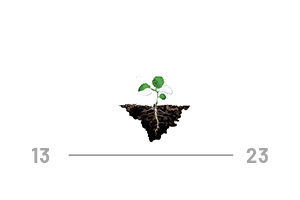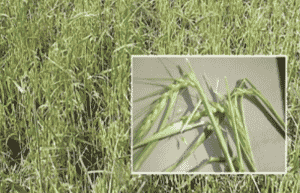
Canola
season and how you can use plant nutrition and biostimulants to maximize the
genetic potential of your canola.
What are the nutritional requirements of a canola crop?
Watch the video to learn about what nutrients are required by a canola crop and the best times to apply them.
Essential nutrition for canola crops
Essential nutrition for canola can be divided into four key stages. Preventing a nutrient deficiency at each of these stages is crucial for preserving the genetic potential of the crop to maximize yield potential. Use the tabs below to learn about the key nutrients required for each stage:
(Herbicide Timing)
(Fungicide Timing)
 Seeds are naturally nutritionally imbalanced – adding a seed nutrient dressing containing the following nutrients can help the seedling get off to a strong start.
Seeds are naturally nutritionally imbalanced – adding a seed nutrient dressing containing the following nutrients can help the seedling get off to a strong start.
- Phosphorus – energy production and photosynthesis
- Zinc – auxin production to drive rooting
- Boron – cell membrane integrity for strong, healthy roots
- Manganese – photosynthesis (responsible for splitting the H2O molecule)
- Biostimulants (Transit-S and Cellburst) can help drive rooting and enhance early seedling vigour, without having negative effects on the inoculant.
- The other key goal with adding biostimulants to the seed is to address and help overcome early season stresses, such as cold soils.

Ensuring the soil is equipped with soil applied nutrients to support the seedling and drive rooting is critical:
To address the needs of the seedlings it is vital to ensure the soil has the key nutrients properly placed (either seed placed or banded close to the seed) to drive rooting, photosynthesis and early season vigor
- Nitrogen – rapid growth
- Phosphorus – “pop-up” effect and energy production
- Potassium – optimize cell membrane potential to increase nutrient uptake, including Boron
- Sulphur – compliments nitrogen for production of amino acids and builds resistant to cold.
- Boron – cell membrane integrity for strong, healthy roots
- Zinc – auxin production to drive rooting
- Biostimulants (Synergro M2) – drive rooting and improved nutrient use efficiency
(Herbicide Timing)

During the vegetative growth stage, the crop is ramping up nutrient demand and energy production while still having a limited root system to acquire nutrients from the soil. The 3 to 5 leaf stage is the ideal timing to combine these critical nutrients with a herbicide application to meet the increased nutritional demand of the crop and optimizing each pass across the field:
- Phosphorus – grows deeper and stronger roots and hastens plant maturity
- Zinc – root and shoot differentiation and moisture acquisition
- Manganese – optimize enzyme production and carbohydrate metabolism
- Boron – regulates metabolism of carbohydrates and enhances calcium, potassium and magnesium uptakes.
- Potassium – optimize carbohydrate movement to the roots to maximize rooting and nutrient uptake.
- Biostimulants (Transit-S and Cellburst) – abiotic stress management, root growth, & improving nutrient uptake and efficiency
(Fungicide Timing)

As the crop moves to the reproductive stage, there are key nutrients essential for pollination and fertilization. Ensuring these nutrients are present in adequate amounts prior to pollination is key:
- Calcium – stigma development and pollination
- Boron – pollen tube structure and development
- Potassium – water relations, carbohydrate movement from leaves and roots (source) to seeds (sink)
- Molybdenum – critical to convert nitrate-N into amino acids and proteins
- Biostimulants (Cellburst) – pollen tube elongation; abiotic stress tolerance
How much nutrition does your crop need?
Use our crop uptake and removal calculator to determine how much of each nutrient is required for your targeted yield.
System of Chemtrition

Developed in the lab and perfected in the field, the Chemtrition three-stage system works in tandem with your seed treatment, herbicide, and fungicide plan to deliver essential nutrients throughout the plant’s life cycle. Release the genetic potential of your crop through a proactive, balanced nutrient plan and get the most out of every acre.
Chemtrition = AgChem + Nutrition
PreCede
+ Seed Protectant
Rate: 6.0 L/MT Timing: Seed

- Increase root development and improve cell wall integrity by eliminating unwanted exudation of carbohydrates and amino acids with the addition of boron.
- Zinc nutrition to drive auxin production in the seed to improve seedling vigour and root growth.
- Enhance early season photosynthesis and overall plant health with the addition of phosphorus. Drive root development and address abiotic stress (cold soils) with the addition of key biostimulants
- Compatible with P solubilizing seed treatments
ReLeaf
+ Herbicide
Rate: 2.0 L/ac Timing: Foliar

- Enhance rooting and maximize photosynthesis with phosphorus.
- Drive sugar movement and proper cell wall integrity with boron.
- Ensure active photosynthetic activity and eliminates flashing during stress periods to drive rooting with proper zinc and manganese nutrition.
- Drive nutrient uptake and efficiency by the plant with key biostimulants
42PHI
+ Fungicide
Rate: 0.5-1.0 L/ac Timing: Foliar

- Optimize sugar movement to the reproductive parts of the canola plant with the supplemental potassium.
- Improve pollen viability with proper zinc nutrition.
- Maximizes auxin production to ensure proper pollen tube growth with boron.
- Improve pollination and pollen tube growth with calcium.
- Maintain ATP production and overall plant health using the optimum load of phosphorus.
Proven Agronomic Performance
Field trials conducted in North America proved the synergistic effects of the System of Chemtrition in Canola, showing an average increase of 19% in Canola yield.

Achieving your genetic potential with canola
ATP’s canola nutrition program helps you achieve the genetic potential of your crop – maximizing yield and quality. ATP’s comprehensive product portfolio provides you with a wide range of options to meet all your canola nutritional requirements.
BBCH
TIMING

Seed Treatment

Soil

Herbicide

Fungicide
Micro-Che
Related Articles

How plant nutrition can help your crop bounce back after a hail event
Is hail a risk to your crop? Here is what you can do to protect it. As we all know, a hail event will put

Importance of Potassium at Flowering
The most stressful time in a plant’s lifecycle is at the start of flowering, due to the increasing nutrient demand of that plant. One of

How to Drive Pollination with Plant Nutrition
To boost yield at the flowering stage of the crop, we need to maximize pollination. Two of the most important nutrients for pollination are Boron

